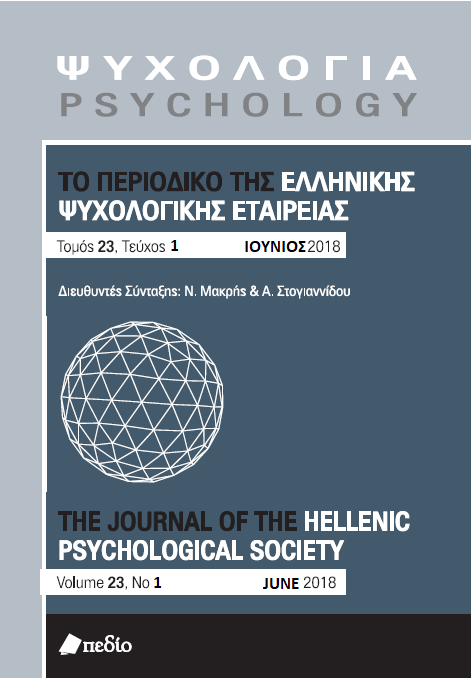Προσανατολισμός δεσμού και κοινωνική αντίληψη του συναισθήματος: Ο ρόλος των κοινωνικών κινήτρων

Περίληψη
Παρά τον πρωταρχικό ρόλο που κατέχει η αντίληψη του συναισθήματος στις διαπροσωπικές σχέσεις, υπάρχει σχετικά περιορισμένη κατανόηση του πώς η οργάνωση δεσμού στους ενήλικες επηρεάζει την αντίληψη του συναισθήματος. Η έρευνα έχει επικεντρωθεί στο πώς οι σχετικές με τους ανασφαλείς προσανατολισμούς δεσμού (αποφυγή, εμμονή) στρατηγικές ρύθμισης του αρνητικού κυρίως συναισθήματος, επηρεάζουν τα αρχικά στάδια επεξεργασίας συναισθηματικών πληροφοριών. Ωστόσο, πρόσφατες μελέτες καταδεικνύουν τη σημασία κοινωνικών διεργασιών και κινητήριων παραμέτρων στην αντίληψη του θετικού και αρνητικού συναισθήματος (βλ. Vrtička, Sander, & Vuilleumier, 2012). Στη βάση κριτικής ανασκόπησης της σχετικής βιβλιογραφίας, το παρόν άρθρο παρουσιάζει αποτελέσματα από ένα πρόσφατο πρόγραμμα μελετών που καταδεικνύουν την επίδραση κοινωνικών παραγόντων του πομπού (σχεσιακό πλαίσιο, κίνητρα κοινωνικής προσέγγισης)
στην ακρίβεια αντίληψης εκφράσεων συναισθήματος σε άτομα με ανασφαλή προσανατολισμό δεσμού. Τα αποτελέσματα από τις πρόσφατες αυτές μελέτες συζητούνται στο πλαίσιο των θεωριών της κινητοποιημένης κοινωνικής νόησης και της κοινωνικής αντίληψης του συναισθήματος.
Λεπτομέρειες άρθρου
- Πώς να δημιουργήσετε Αναφορές
-
Ανδριοπούλου Π., & Καφέτσιος Κ. (2020). Προσανατολισμός δεσμού και κοινωνική αντίληψη του συναισθήματος: Ο ρόλος των κοινωνικών κινήτρων. Ψυχολογία: το περιοδικό της Ελληνικής Ψυχολογικής Εταιρείας, 21(3), 319–333. https://doi.org/10.12681/psy_hps.23501
- Τεύχος
- Τόμ. 21 Αρ. 3 (2014)
- Ενότητα
- ΕΙΔΙΚΟ ΑΦΙΕΡΩΜΑ

Αυτή η εργασία είναι αδειοδοτημένη υπό το Creative Commons Attribution-ShareAlike 4.0 International License.
Το περιοδικό ΨΥΧΟΛΟΓΙΑ έχει υιοθετήσει μία πολιτική Platinum open-access. Τα έξοδα υποβολής, επεξεργασίας ή δημοσίευσης των εργασιών καλύπτονται από την Ελληνική Ψυχολογική Εταιρεία. Τα πνευματικά δικαιώματα των δημοσιευμένων εργασιών προστατεύονται από την άδεια 'Creative Commons Attribution-ShareAlike 4.0 International'. Οι Συγγραφείς διατηρούν τα Πνευματικά Δικαιώματα και χορηγούν στο περιοδικό το δικαίωμα της πρώτης δημοσίευσης. Η άδεια αυτή επιτρέπει σε τρίτους, να χρησιμοποιούν την εργασία σε οποιαδήποτε μορφή, με την προϋπόθεση της διατήρησης των διατυπώσεων που προβλέπονται στην άδεια σχετικά με την αναφορά στον αρχικό δημιουργό και την αρχική δημοσίευση στο περιοδικό ΨΥΧΟΛΟΓΙΑ. Επιπλέον, κάθε διανομή της εργασίας οφείλει να γίνεται με τους ίδιους όρους διανομής, δηλαδή με την ίδια άδεια Creative Commons.






